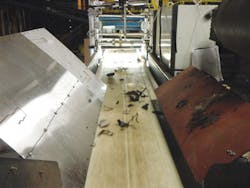Systems Integration: Machine vision assists scrap sorting
According to a report released by Solving the E-waste Problem (StEP), a United Nations University Initiative formed to tackle the problem of electronic waste recycling, one million cellphones can yield 24kg of gold, 250kg of silver, 9kg of palladium and more than 9 tonnes of copper. As well as providing a source of revenue for recycling companies, supplying recycled materials to industry is typically more energy efficient than the process of extracting, refining and processing raw substances.
For PADNOS (Holland, MI, USA; www.padnos.com), a company that manages scrap for industrial and commercial accounts throughout the United States, the sorting process is made more efficient by including a machine vision system to automatically remove copper, circuit board or wires.
Developed by Soft Automation (Milford, MI, USA; www.softautomation.com), the system employs a color line scan camera, PC host, high-speed I/O and numerous air and paddle rejection mechanisms to perform this task. "Before products such as cellphones, cars and televisions can be recycled," says Frank Meyer, President of Soft Automation, "they are crushed before the raw materials from which they are composed can be sorted and finally extracted."
At PADNOS, this crushed material is then placed onto a 3ft-wide conveyor running at 300ft/min. To automatically sort this material, a GigE line scan camera fitted with an F-mount lens is placed approximately 1m above the conveyor. By capturing successive line scan images, a 6k x 2k color image is buffered into the PC memory for processing. Tools from Soft Automation's Automation Manager Software are then used to identify the shape and color of each object on the conveyor.
Once identified, a multi-channel PCI Express I/O card from Measurement Computing (Norton, MA, USA; www.mccdaq.com) is used to trigger the relays that control air jets and mechanical paddles at the end of the conveyor. Identified material can then be ejected either by 56 pneumatically-controlled air jets placed across the 3ft-wide conveyor that are used to blow the product upward into a separate conveyor or 14 mechanical paddles that are used to push the product downward depending on the results calculated by the vision system. In operation, the software performs the machine vision analysis and product ejection with a typical response time of approximately 1.2 ms.

